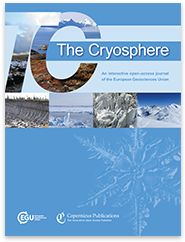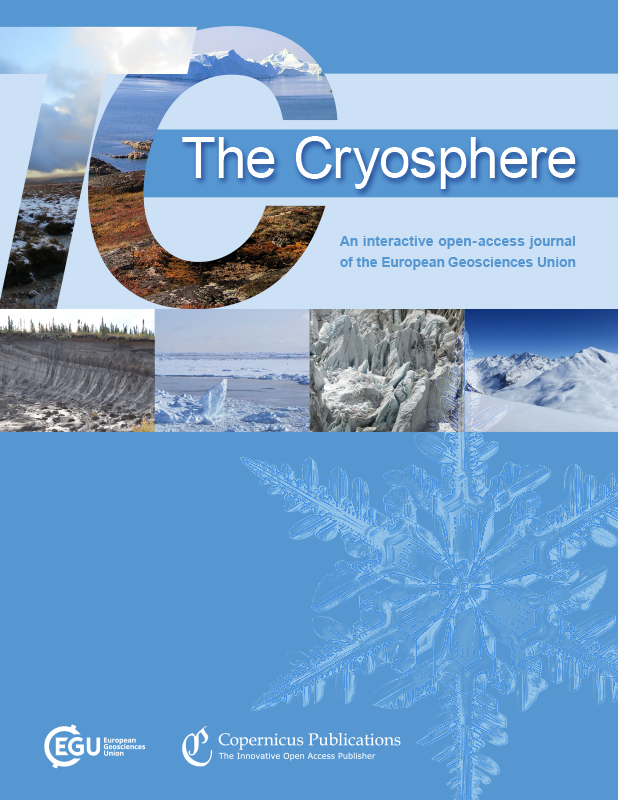Co-editors-in-chief: Caroline Clason, Chris Derksen, Christian Haas, Christian Hauck, Nanna Bjørnholt Karlsson, Hanna Lee & Thomas Mölg
eISSN: TC 1994-0424, TCD 1994-0440
The Cryosphere (TC) is a not-for-profit international scientific journal dedicated to the publication and discussion of research articles, short communications, and review papers on all aspects of frozen water and frozen ground on Earth and on other planetary bodies.
The main subject areas are ice sheets and glaciers, permafrost, river and lake ice, seasonal snow cover, and sea ice, including remote sensing, numerical modeling, in situ, and laboratory approaches, and studies of the interaction of the cryosphere with the Earth system. Manuscripts with a focus on cryospheric research that include perspectives from social science, humanities, and other disciplines outside the natural sciences are also welcome.
Journal metrics
TC is indexed in the Web of Science, Scopus, Google Scholar, etc. We refrain from displaying the journal metrics prominently on the landing page since citation metrics used in isolation do not describe importance, impact, or quality of a journal. However, these metrics can be found on the journal metrics page.
News
03 Dec 2025
New MS Word template available for manuscript preparation
The existing MS Word template for authors has been significantly expanded and now includes many important notes on the standard sections that must be included in the manuscript. Please visit the "Submission" page, section "Templates for your manuscript file" and download the new template before writing your next manuscript. 
03 Dec 2025
New MS Word template available for manuscript preparation
The existing MS Word template for authors has been significantly expanded and now includes many important notes on the standard sections that must be included in the manuscript. Please visit the "Submission" page, section "Templates for your manuscript file" and download the new template before writing your next manuscript. 
08 Jan 2026
Modelled dynamics of floating and grounded icebergs, with application to the Amundsen Sea
Yavor Kostov, Paul R. Holland, Kelly A. Hogan, James A. Smith, Nicolas C. Jourdain, Pierre Mathiot, Anna Olivé Abelló, Andrew H. Fleming, and Andrew J. S. Meijers
The Cryosphere, 20, 135–169, https://doi.org/10.5194/tc-20-135-2026,https://doi.org/10.5194/tc-20-135-2026, 2026
Short summary
08 Jan 2026
Brief Communication: Inferring Glacier Equilibrium Line Altitudes in Central Europe with FROST
Oskar Herrmann, Veena Prasad, Anna Zöller, Alexander R. Groos, Samuel Cook, Christian Sommer, and Johannes J. Fürst
EGUsphere, https://doi.org/10.5194/egusphere-2025-5486,https://doi.org/10.5194/egusphere-2025-5486, 2026
Preprint under review for TC (discussion: open, 0 comments)
Short summary
Highlight articles
18 Nov 2025
Recent history and future demise of Jostedalsbreen, the largest ice cap in mainland Europe
Henning Åkesson, Kamilla Hauknes Sjursen, Thomas Vikhamar Schuler, Thorben Dunse, Liss Marie Andreassen, Mette Kusk Gillespie, Benjamin Aubrey Robson, Thomas Schellenberger, and Jacob Clement Yde
The Cryosphere, 19, 5871–5902, https://doi.org/10.5194/tc-19-5871-2025,https://doi.org/10.5194/tc-19-5871-2025, 2025
Short summary
30 Oct 2025
Formation of mega-scale glacial lineations far inland beneath the onset of the Northeast Greenland Ice Stream
Charlotte M. Carter, Steven Franke, Daniela Jansen, Chris R. Stokes, Veit Helm, John Paden, and Olaf Eisen
The Cryosphere, 19, 5299–5315, https://doi.org/10.5194/tc-19-5299-2025,https://doi.org/10.5194/tc-19-5299-2025, 2025
Short summary
15 Oct 2025
TICOI: an operational Python package to generate regular glacier velocity time series
Laurane Charrier, Amaury Dehecq, Lei Guo, Fanny Brun, Romain Millan, Nathan Lioret, Luke Copland, Nathan Maier, Christine Dow, and Paul Halas
The Cryosphere, 19, 4555–4583, https://doi.org/10.5194/tc-19-4555-2025,https://doi.org/10.5194/tc-19-4555-2025, 2025
Short summary
16 Sep 2025
Drift-aware sea ice thickness maps from satellite remote sensing
Robert Ricker, Thomas Lavergne, Stefan Hendricks, Stephan Paul, Emily Down, Mari Anne Killie, and Marion Bocquet
The Cryosphere, 19, 3785–3803, https://doi.org/10.5194/tc-19-3785-2025,https://doi.org/10.5194/tc-19-3785-2025, 2025
Short summary
More highlight articles  All EGU highlight articles
All EGU highlight articles 
Notice on the current situation in Ukraine
To show our support for Ukraine, all fees for papers from authors (first or corresponding authors) affiliated to Ukrainian institutions are automatically waived, regardless if these papers are co-authored by scientists affiliated to Russian and/or Belarusian institutions. The only exception will be if the corresponding author or first contact (contractual partner of Copernicus) are from a Russian and/or Belarusian institution, in that case the APCs are not waived.
In accordance with current European restrictions, Copernicus Publications does not step into business relations with and issue APC-invoices (articles processing charges) to Russian and Belarusian institutions. The peer-review process and scientific exchange of our journals including preprint posting is not affected. However, these restrictions require that the first contact (contractual partner of Copernicus) has an affiliation and invoice address outside Russia or Belarus.





